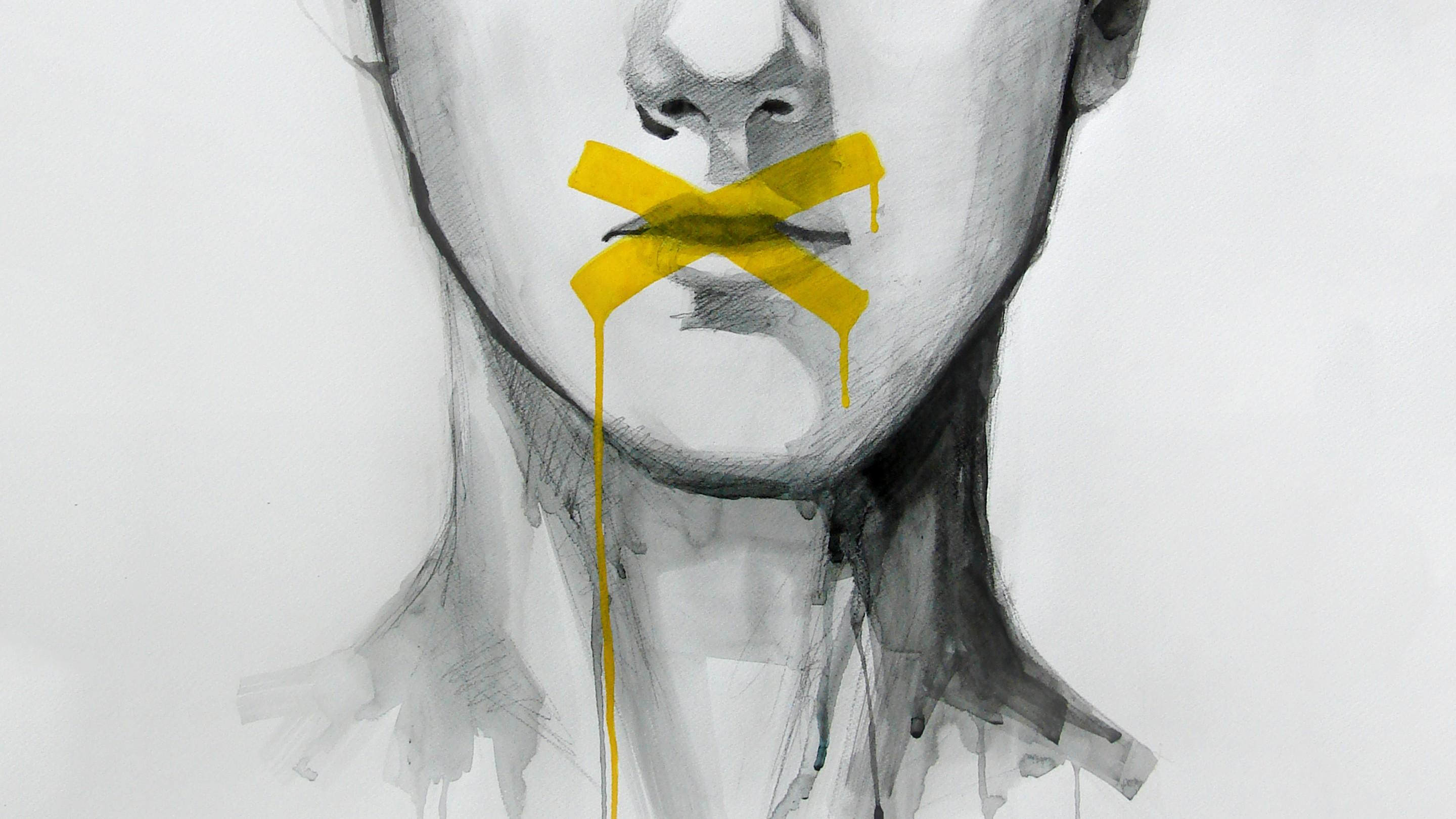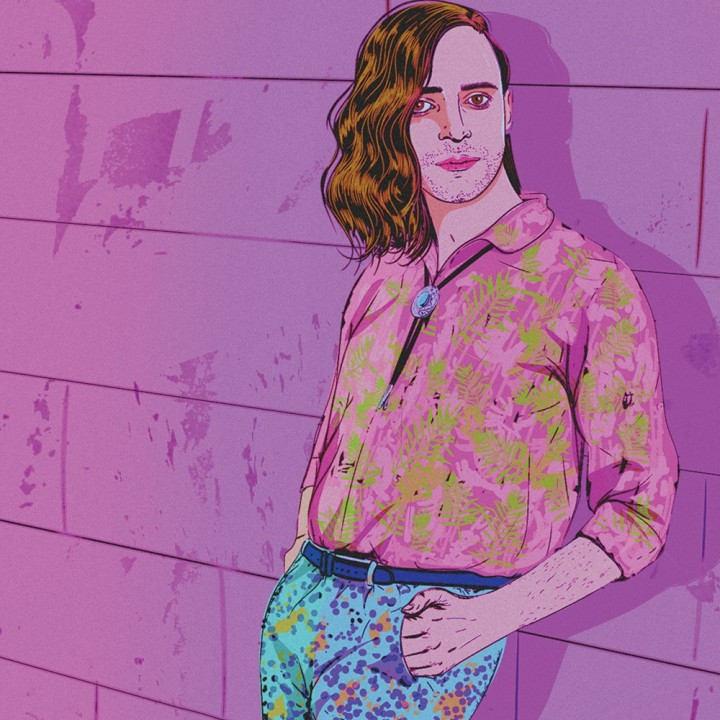
The Fight to Erase the Silencing of Male Victims in America
1in6 is one of the few organizations hoping to help male victims—and no one wants to fund it
One month after the news broke about Harvey Weinstein and troves of women came forward about abuses, Anthony Edwards, star of NBC’s long-running drama ER, wrote a story for Medium about having been sexually assaulted by film producer Gary Goddard. In his piece, Edwards says that he was 12 years old when he met Goddard, a “sick father figure” who taught him and his friends how to act. Edwards refers to Goddard as a “pedophile,” alleging he was sexually assaulted by Goddard; his childhood best friend, he says, had been raped by him.
Edwards says that since male survivors have such a long history of suppressing feelings and never sharing, he believes that “#MeToo is helping everyone stand up and shows how much relief there is when people don’t feel isolated and alone with their experience.” Of course, there's been an emotional outpouring of sentiment and kinetic energy inspired by the #MeToo and #TimesUp campaigns in our country, but Edwards’ story represents a rare instance in which that narrative was told from the male perspective, joining accounts from actors Terry Crews and Anthony Rapp. Indeed, the injustices that have befallen women were ignored or minimized for far too long and justifiably, men are finally being put to task for their unseemly and predatory behavior. But this does not mean men are not often victims themselves of sexual abuse, assault and harassment. Despite #MeToo having sparked a revolution of empowerment in terms of how we see each other—and why we need to relearn how to relate to each other—male victims are in no better position some six months later.
Edwards, now 55 years old, credits 1in6 for being the primary resource for him as he worked through his process of healing. Now in its 11th year, 1in6 has been recently hit by a tsunami of calls from men looking for help. “We’re up 30 percent,” say Steve LePore, founder of 1in6. “It’s become our new normal.” LePore heads the only national non-profit organization, with a fully paid staff, focused solely on advocating for and the intervention of male survivors of sexual violence.
1in6 got its name because of the stupefying statistic that one in six American men are likely to be sexually assaulted in their lifetimes, with some research suggesting it may even be closer to one in four. The organization offers a 24/7 online help line where male survivors of sexual trauma and the people who care about them can chat one-on-one with a trained advocate. Additionally, it offers free confidential weekly online support groups as well as trauma-informed trainings and webinars for service providers and organizations around the world.
There's also the Bristlecone Project, an online awareness campaign, featuring a collection of portraits, videos and written narratives of male survivors of sexual abuse and assault. “The #MeToo movement is creating awareness. They may not mention 1in6 specifically, but awareness is being created in the consciousness of our culture and our society,” LePore says.
For perspective, the number of men who have experienced sexual abuse as children is equal to those who will develop prostate cancer—the most common and leading cause of cancer death among men. The difference is that prostate cancer motivates national fundraising efforts and awareness campaigns, while the issue of male sexual trauma is a hard sell, to say the least.
LaPore is forthcoming about the extreme difficulty of continuing to fund an organization like his. Simply put, women are more easily seen as victims whereas men are usually seen as the problem.
Eventually, the seed money for 1in6 came from the Weingart Foundation, and LePore credits the organization for its monumental courage and foresight. But the reality is that steady resources remain paltry. He is forthcoming about the extreme difficulty of continuing to fund an organization like his. Simply put, women are more easily seen as victims, whereas men are usually seen as the problem.
LePore says it’s the chicken or the egg issue. Because of a survivor’s shame and the overwhelming feeling that they’re the only ones who’ve been victimized, they rarely report their trauma. So resources that could be allocated to their cause are unfortunately allocated elsewhere. “We are a national organization and we fight for every nickel we get. We look under every rock. It's unbelievable. Even 11 years later it is no easier to fund this today than it was 11 years ago,” LePore says.
The emotional impact of delaying recovery can systematically ripple out to every area of a survivor’s life—and the lives of those in his community. Men who do not get help risk exposure to greater physical health issues, including substance abuse, self-destructive behavior, chronic health conditions, mental health issues (including depression, suicide and PTSD) and social dysfunction.
Living within a kind of secret fraternity, male survivors say their traumas stay hidden in an effort to protect themselves from the guilt of not being masculine enough, not being able to ‘man up’ or not being able to fight through the pain. Many even feel that they may have somehow been responsible for their abuse or assault. Women who have been abused often cite the feelings of isolation and confusion, but these feelings are grotesquely amplified in men. It is the antithesis of what a man represents in our society.
M.E. Hart was sexually abused by extended family starting at the age of four, and continuing until around 14. After coming forward to friends and family, Hart says he was so desperate to find help he looked to female-based organizations and attempted to apply the information for women's recovery to himself. He says it made him feel “re-victimized” because what he was hearing was that sexual abuse and assault is primarily caused by men, that all men are dogs, and that it’s all the fault of men.
The probability for alcohol problems in adulthood is about 80 percent for men who have experienced sexual abuse, as compared to 11 percent for men who have never been sexually abused.
Actor and screenwriter Joe Capozzi is a survivor of clergy abuse. It began when he was around age seven, when Capozzi’s family would have the man he calls Father Pete, over for Sunday dinners. The abuse continued until Capozzi was in his late 20s. Father Pete even officiated Capozzi’s wedding.
In many cases of early-life male sexual abuse, particularly when the abuse is perpetrated by a trusted family member or friend, it can be incredibly confusing for the survivor, who may rely on the perpetrator for emotional support or friendship. This form of trauma is known as “attachment trauma,” and it nearly always creates stronger and ultimately more destructive responses. Like any uneven power dynamic, it often leads to survivors internalizing self-blame.
It took Capozzi decades to finally come forward about his abuse and his delayed reaction is common among survivors. “When the women started coming forward I identified so much with them. They were getting hammered in the press. You know, it was like they were the crazy ones. It’s interesting though now with Harvey Weinstein and it's like Hollywood and people will pay attention more to what’s going on in Hollywood. Look at what happened in gymnastics with Larry Nassar. People will tend to listen to the flashier stuff. And you know what, that’s fine...as long as people are talking about it,” Capozzi says.
But when Marcel Anderson, 33, chose to talk about his story, he says his shame became acute when some members of his faith community admonished him. Anderson was violently raped at gunpoint during a home invasion five years ago in North Carolina. As he was helping a friend move, someone broke into the house and attacked him. He was handcuffed, blindfolded and sodomized. “Being raised in the church, we’re always told to let God handle it. He’ll work it out. You don’t need counseling. You don’t need support to help you. And that’s a pure lie. There’s this stigma that men should be strong enough... Just get through it. We don’t talk about it,” Anderson says.
He adds that he was even made to feel as if he needed to “defend his sexuality.” Anderson, who is straight, says clergy and other members of his church asked him if after the rape he felt more “connected” or “attracted” to men. “Whether I live in that lifestyle or not, we as survivors have something in common. We have been violated. We have been taken advantage of, and we share a commonality as individuals, and we’re looked at differently because of what we’ve experienced."
Anderson says 1in6 board president David Lisak was the first person he was able to speak with after his rape. “Eventually he became an advocate and mentor for me during my journey,” he says. Lisak, is a clinical psychologist, forensic consultant and a survivor of childhood sexual violence. He says the greatest way to defeat stigma and for survivors to start to get the help they need is for them to be willing to speak openly.
It is the shame, carried by his male patients that is the backbone of Lisak’s work with The Bristlecone Project, the aforementioned online photo and story experience that asks men to tell their stories through media. It’s the only one of its kind, and it is a project that 1n6 hopes will get the word out.
Founded in 2012, The Bristlecone Project was named after the bristlecone pine, a long-lived and highly resilient tree. The site features the faces, names and stories of survivors. It launched initially with only seven men, but has grown to 121, with another 100 men waiting to be featured. “You know their names and faces. It’s not every day that men I work with are willing to do that. What we hope and we know is that other men who have survived either childhood or adult adolescent sexual assault, see the site and it gives them the courage and strength to at least disclose to somebody. I suppose they can borrow from the courage of these guys willing to put themselves out there,” Lisak says.
Anderson’s story is one of those featured on the Bristlecone website. “I was so honored and grateful that I was able to connect with David and his team to share not only my story but also be a part of a national movement, addressing social issues head on and knowing that I wasn't by myself. I was with a group of guys, straight or gay, no matter what their lifestyle, and we were all on the same page working together to resolve to end sexual violence against men and to advocate and speak up about it,” Anderson says.
I felt like this when The Boston Globe broke the story on the church and pedophilia, and Penn State football coach Jerry Sandusky, I thought that would be a watershed moment, but it soon fell by the wayside, and that’s what I’m worried about with #MeToo.
The numbers of assaults on men are sobering. “[About] 10,800 men are sexually assaulted every year in the military,” Russell Strand, a retired Criminal Investigative Service special agent, said in the Army's Sexual Harassment/Assault Response Program Summit, held by the Department of Defense in 2015. 1in6 spends a lot of time working with various branches of the military, offering 90-minute presentations and clinical trainings and helping frontline workers to better understand how to respond to a man who might have a flashback or who may come forward to tell what happened to them.
The U.S. Department of Veterans Affairs reports that male survivors [veterans] also have a higher rate of drug and alcohol abuse and addiction. The probability for alcohol problems in adulthood is about 80 percent for men who have experienced sexual abuse, as compared to 11 percent for men who have never been sexually abused.
Since most Sexual Assault Prevention and Response training is primarily gender-neutral or focused almost exclusively on female survivors, the work 1in6 is doing is important, needed and in fact, revolutionary. But, LePore offers a lot of praise and respect for the innovative and foreword thinking of the US military. “What many might perceive as a slow moving archaic machine [the military] is leading the charge in my opinion with regard to this issue specific to men,” LePore says.
Michael Skinner, now age 63, was sexually abused by both of his parents and some of their friends until he was around 18. Skinner believes his parents and their friends were part of a pedophile ring. He says he’s been an active advocate since 1993, and became aware of 1in6 when they first came on the scene in 2007. “1in6 has helped in raising awareness about how many males are impacted by sexual abuse, and getting the conversation out there about the long term impact it has on the victim—the survivor of these crimes,” Skinner says.
“There is more awareness of the abuse of males, but there is still a lot of push-back and denial by so many, dismissing the assaults males have experienced. 1in6 helps in countering the silence that many in society still resort to,” adds Skinner, who didn’t reveal his story to anyone until more than two decades after his abuse ended. By that time, he was married and had five children, and when he finally told someone, he ended up having a mental breakdown. “I was 39 years old, married and a homeowner. I owned a business. I was successful. I was playing in a band on the weekends. Then I entered the mental health system,” Skinner says.
“They gave me the diagnosis of post-traumatic stress disorder and major depression. They treated me like a child and they wouldn’t treat the trauma. They basically just medicated me. That went on for years until I found a survivor group. That’s when I was really able to start working on the trauma. But even in 2018 it’s still hard. People are aware that there’s trauma in people’s lives, but they’re still using the medical model for all of this and lots of drugs, and hoping it will silence survivors,” Skinner adds.
Kimberly Resnick, a sex therapist and clinical instructor of psychiatry at UCLA David Geffen School of Medicine, says one major deterrent keeping male survivors from coming forward and asking for help, is the ongoing perception that they’ll be perceived as future perpetrators of sexual abuse. “The last statistic I last saw was that men perpetrate 86 to 90 percent of sexual assaults against children," Resnick says. "That said, many abusers were not abused as children, and those people who were abused as children, do not grow up to abuse. So, although having been abused may increase your risk factors of becoming an abuser, a lot of abusers have no history of ever being abused.”
LePore notes that the attitudes about male survivors becoming offenders themselves is so powerful that guys won’t tell their partners because they fear they won’t want to have children around them. And they won’t tell church members, as they’re afraid they won’t be allowed to work with youth groups. “If you call a sexual assault center looking for help or services they're treating you like you're a perp because you're a male. So you retreat inside even more. I still hear this in my travels, and I see it on different groups I belong to on Facebook. Guys still feel like they’re being treated like the perpetrators,” Skinner says.
Andrew Irwin-Smiler is a therapist and the board president or MaleSurvivor.org, an all-volunteer nonprofit providing training to mental health professionals and some resources to male survivors. He says men may feel less than welcome to seek help when the majority of therapists are female. “We talk about men as an underserved population…Psychology used to be 70 to 80 percent male, and that number has flipped… we teach white people how to work with non-white populations and straight people about LGBTQ+, but there’s no point where we teach female people how to work with males,” Smiller says.
Everyone working and living in the world of male sexual assault agrees on one salient point: the more men who come forward about their abuse, the more resources could become available for consultation and treatment for the abused.
Patricia Giggans, the executive director with Peace Over Violence and a former 1in6 board member, believes that the #MeToo movement could be a sort of double-edged sword for male survivors. Peace Over Violence is a 35-year-old non-profit primarily focusing on women’s issues and programs to end domestic and sexual violence. “So, the other side of the #MeToo piece is that it’s very possible that you have men who have been traumatized through sexual violence and other things, who also have some misconduct in their background. “There are a lot of consequences for men who have been called out on sexual misconduct. They're losing their jobs. This has never happened like this before,” Giggens says.
Skinner says he wishes for what he calls the “silo” of the #MeToo movement to include more men. “It’s the silos that keep us from working together. On the one hand #MeToo is great, and I hope this energy keeps going forward. I felt like this when The Boston Globe broke the story on the church and pedophilia, and Penn State football coach Jerry Sandusky, I thought that would be a watershed moment, but it soon fell by the wayside, and that’s what I’m worried about with #MeToo. It’s getting press now, but at some point it’s going to get buried, until they find the next Larry Nassar,” Skinner says.
Finally, like Skinner, LePore hopes that the conversation around sexual abuse and assault will some day include men, not just as potential offenders or as bystanders or allies, but guys who are simply people who need help too. “We come in the shadow of pioneers, almost all of whom are women, and we're grateful. They've made our job easier. It's not easy, but it's easier. I can't tell you how many high-profile celebrities, musicians and athletes are affected, but you can't talk about it publicly because it will harm their careers and because of the shame of having had this happen to them. And I don't want every guy that this happened to, to raise this hand and say ‘this happened to me,’ but I'd love for them not to have the kind of shame that keeps them too paralyzed to ask for help,” LePore says.
Hart talks about a time in his survivor’s group counseling session when he was the youngest man and the oldest man in the group was in his late 60s. “One of the things that prompted me to continue the work toward my own healing was when that man, with tears in his eyes, said, ‘I cannot believe how much of my life I have lost to this.’ And so unfortunately, his pain and horror became my inspiration and motivation to say ‘this is not going to define me. This is not going to control my opportunities in life. And this is not going to be the thing that is the most important thing in my life.”
Illustration by re_bekka / Shutterstock.






